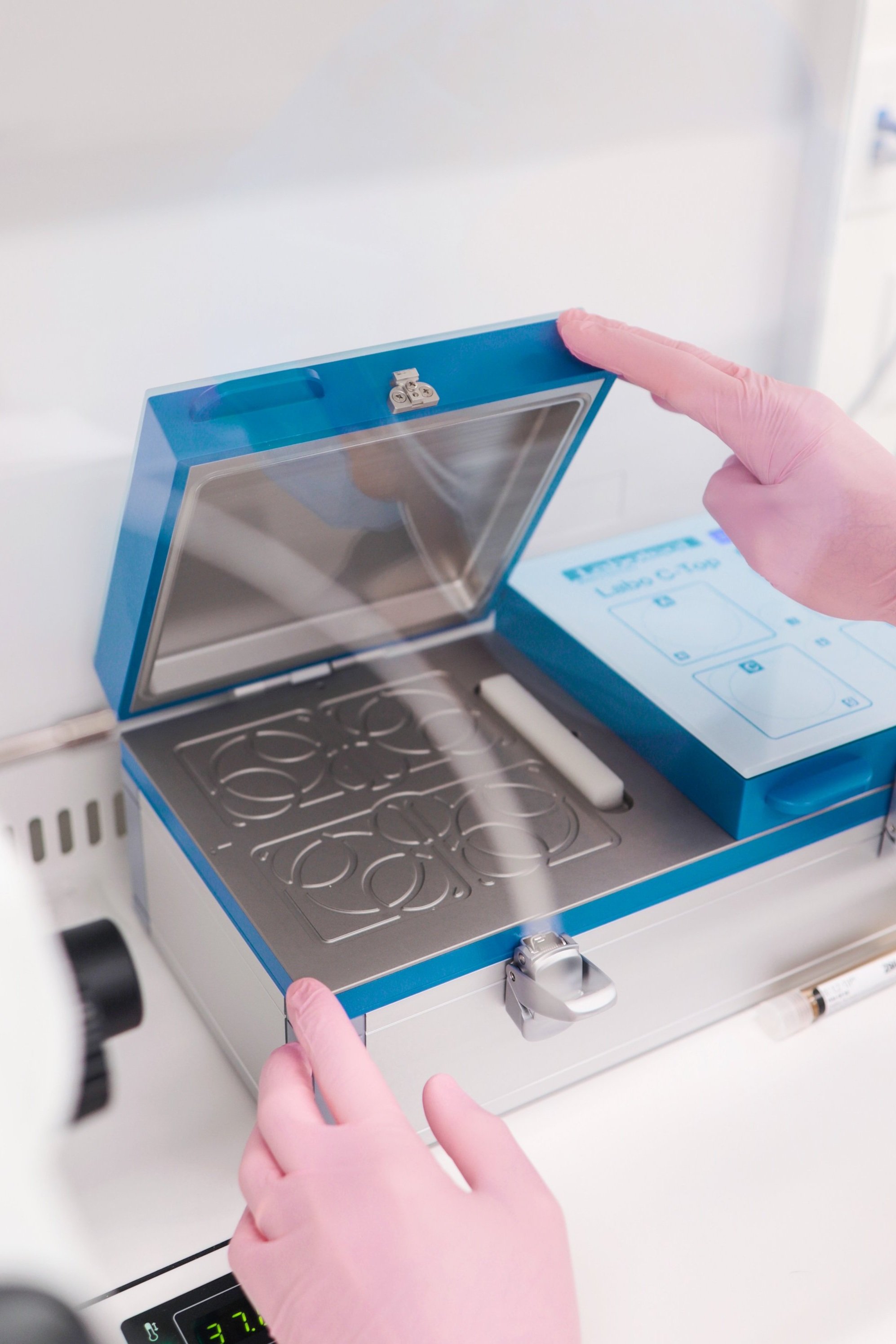Our services
In vitro fertilization (IVF) is a process of fertilization where an egg is combined with sperm in-vitro ("on glass") or more appropriately on a petri dish. Typically women will have their ovaries stimulated with medications in a controlled manner for approximately 9 to 12 days. She will then undergo a small procedure under a light anesthetic where the oocytes (or eggs) will be retrieved under ultrasound guidance.
Once the oocytes are retrieved they are fertilized with the sperm and then closely monitored in the embryology laboratory. The fertilized egg (or zygote) then undergoes embryo culture for days and is given a grade by the embryologists. Less often now, it is transferred fresh into the woman’s uterus whereas more typically it is cryopreserved or frozen and then transferred into the uterus at a later date. The embryo(s) may be screened with pre-implantation genetic testing (PGT) prior to freezing depending upon the patient(s) unique history.
In Vitro Fertilization (IVF)
With the improvement in egg freezing technology (vitrification versus the older less reliable slow freeze method), females are now able to better preserve their fertility when they are younger. Fertilization rates and pregnancy rates with frozen thawed eggs is very similar to fresh eggs. Now, there are not only donor sperm banks, but there are also donor egg banks.
Remember that egg and embryo quality begin to decline after the ages of 33, 34, or more certainly after 35 years old. Age related fertility preservation is a very common way to improve one’s chances of pregnancy in the future, especially if you haven’t met a male partner or that you would like to focus on your career, travel, or just life! We also regularly cryopreserve a woman’s oocytes prior to cancer treatments that may be particularly harmful to the ovaries and egg numbers such as certain chemotherapies (eg., alkylating agents such as cyclophosphamide that is often used for breast cancer) or pelvic radiation. Lastly, females may now freeze their gametes (oocytes or eggs) prior to transitioning with the use of exogenous androgens (testosterone).
The process of egg freezing is similar to the first part of IVF. Typically women will have their ovaries stimulated with medications in a controlled manner for approximately 9 to 12 days. The female will then undergo a small procedure under a light anesthetic where the oocytes will be retrieved under ultrasound guidance. Once the oocytes are retrieved, they will be “snap-frozen” or vitrified using very precise techniques. If stored properly, the oocytes should last greater than 5 to 10 years ideally.
Egg Freezing
Intra-Uterine Insemination is a more basic technique that is used to wash and concentrate a semen sample while also inseminating it into the mid-body of the uterus. It is often used in conjunction with ovulation induction medications such as Clomid® (clomiphene citrate), Femara® (letrozole), and/or Pregnyl® (hCG). Pregnancy rates are often improved using IUI versus Clomid with timed intercourse depending upon an individual’s unique medical history. Single women or LGBTQ females may also conceive with IUI using donor-sperm insemination. Oftentimes providers recommend to obtain pre-washed samples.
Intrauterine Insemination (IUI)
Recurrent Miscarriages
Miscarriage is far more common than most people think. 1 in every 4 clinically-recognized pregnancies is lost in the first trimester. You are not broken if you’ve had a miscarriage(s). Many times it’s “Nature’s Way” of understanding that was not a good pregnancy.
What to do? If you’re had recurrent miscarriages i.e., two or more consecutive pregnancy losses, you should rule certain causes. Step 1 is to see a physician who can order and interpret the RPL panel of blood tests. The general categories include: Endocrine (aka hormonal testing), Immune (checking for a variety of antibodies), Chromosomal (obtain karyotypes for male and female partners to screen for translocations, Anatomic (screen for septums, scar tissue, etc..) and Male (obtain a DNA fragmentation test for the sperm). Step 2 involves treatment of any pertinent cause.
Egg Donation
This process entails a woman donates her oocytes (aka eggs) to another person to allow them to conceive a child with assisted reproductive care. The process is regulated by the FDA to ensure safety. Typically, a younger woman who is in her 20’s will go through ovarian stimulation to mature and grow her ovarian follicles and eggs while being precisely monitored by a reproductive endocrinologist. After egg retrieval, the eggs will be fertilized by the sperm source of the future parent(s) desire. Egg donors will undergo infectious disease testing, genetic carrier screening, psychological assessment, and legal clearance prior to starting medications. Most often people use fresh donor eggs to create embryos, but some will opt to use thawed frozen donor eggs depending upon the future parent(s) unique needs and desires.
Pre-implantation Genetic Testing (PGT)
Pre-implantation genetic testing is an advanced embryology technique that may be used to screen the embryo(s). The most common version of PGT is PGT-A where one is able to screen for Aneuploidy or chromosome number. Humans typically have 46 chromosomes (46,XY for males and 46,XX for females). Frequent causes for miscarriage involve cases when the embryo or early pregnancy is aneuploid or has the wrong number of chromosomes as is seen with Down Syndrome (trisomy 21).
Indications for PGT-A vary. Because women are at higher risk of aneuploidy as they age, especially after 35 years old. Therefore, PGT-A is often used when women age to best avoid implanting embryo with the “wrong” number of chromosomes. The testing is thought to be approximately 96 to 97% accurate when accounting for all of the pairs of chromosomes. PGT-A also allows individuals to know the biological sex (male or female) of the embryo with extremely high accuracy (99.8%) prior to embryo transfer.
Other types of PGT are less often used, but highly indicated depending upon an individual’s history. PGT-M can screen the embryo for rare Monogenic disorders such as cystic fibrosis or BRCA1/2. Reports from PGT-M will document if a specific embryo is affected or not. Lastly, PGT-SR can also screen embryos for translocations or Segmental Rearrangements. Men and women with balanced translocations are at high risk for recurrent miscarriages. By using PGT-SR, individuals with translocations can better select the embryo for transfer and decrease the risk of miscarriage.
The treatment for PCOS varies depending upon a female’s age, life goals, and desire to conceive. For those with fertility issues and PCOS, step 1 is to always focus upong nutrition and a healthy lifestyle. Step 2 often involves ways to improve ovulation such as Clomid® (clomiphene citrate), Femara® (letrozole), and/or Pregnyl® (hCG). Step 2b often helps to decrease a female’s insulin resistance with compounds such as myo-inostitol and/or metformin. Step 3 is often IVF or in-vitro fertilization with particular stimulation protocols tailored to your condition as women may be at higher risk for ovarian hyperstimulation.
PCOS Treatment
The drawbacks to traditional surrogacy can be difficult for some people. The surrogate might feel like she's lost two children, and there is the bond between parent-surrogate which needs careful consideration in order not break up this special relationship too soon after birth
A lot goes into choosing an appropriate carrier: genetic compatibility with either side of your family (or all three), physical health status
Surrogacy
Contact Me
-
P: (866) 472-4483
E: info@drjohnnorian.com
Address: 55 South Lake Ave, 9th floor, Pasadena, CA 91101
-
P: (866) 472-4483
E: info@drjohnnorian.com
Address: 8112 Milliken AVe, #101, Rancho Cucamonga, CA 91730







